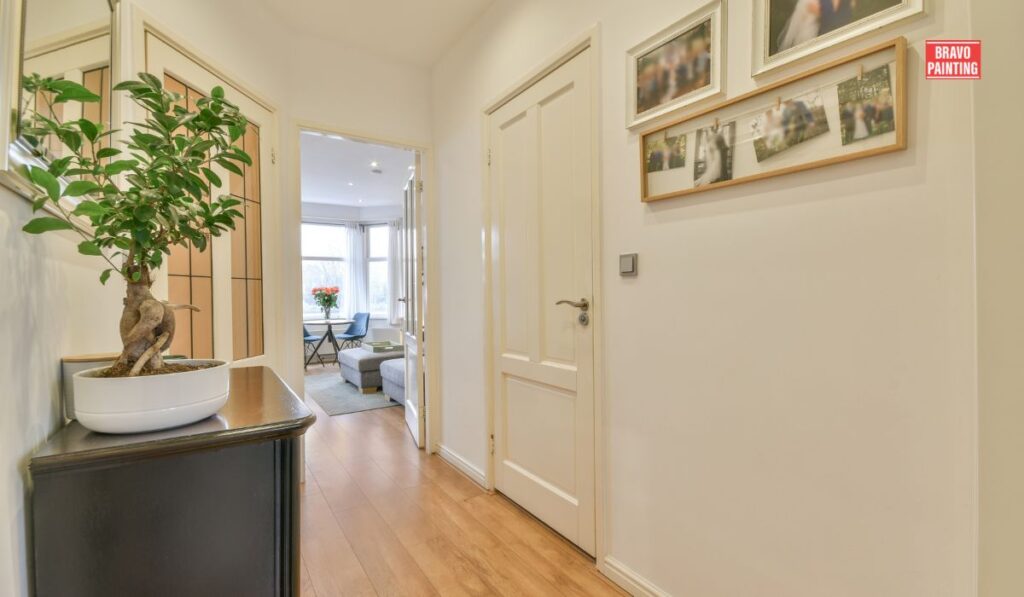Maintaining the pristine look of your residential interior paint enhances the aesthetic appeal of your home and prolongs the lifespan of your paint job.
With a few simple maintenance practices, you can ensure that your interior paint continues to look fresh and vibrant for years to come.
In this article, we’ll explore some essential tips for keeping your residential interior paint looking new.
Regular Cleaning:
Dust, dirt, and grime can accumulate on painted surfaces over time, dulling their appearance.
Regular cleaning is essential to prevent this buildup.
Use a soft cloth or sponge dampened with mild, soapy water to wipe down walls and other painted surfaces gently.
Avoid using abrasive cleaners or harsh chemicals, as they can damage the paint finish.
Address Stains Promptly:
Accidents happen, and stains are inevitable in a household.
Whether it’s a spill, splatter, or smear, it’s crucial to address stains promptly to prevent them from setting into the paint.
Blot the stain with a clean cloth or paper towel to absorb as much of the substance as possible, then gently clean the area with a mild cleaning solution.
Avoid scrubbing vigorously, as this can damage the paint.

Touch Up as Needed:
Over time, painted surfaces may develop minor imperfections such as chips, scratches, or scuffs.
Keep a small supply of touch-up paint on hand to address these issues promptly.
Before applying touch-up paint, clean the area thoroughly and allow it to dry completely.
Use a small brush or roller to apply the paint carefully, feathering the edges to blend it seamlessly with the surrounding area.
Control Humidity Levels:
High humidity levels can contribute to paint peeling, cracking, or bubbling, especially in areas such as bathrooms, kitchens, and basements.
Use exhaust fans or dehumidifiers to control humidity levels in these spaces.
Additionally, consider using moisture-resistant paint in areas prone to high humidity to provide added protection against moisture damage.
Protect Walls from Furniture and Decor:
Furniture, decorations, and other objects can inadvertently damage painted walls if not adequately protected.
Place felt pads or rubber bumpers on the bottoms of furniture legs to prevent scratches and scuffs.
Use wall protectors such as adhesive-backed felt or rubber pads behind picture frames and other wall-mounted items to prevent them from rubbing against the paint.
Avoid Excessive Sun Exposure:
Direct sunlight can cause painted surfaces to fade and discolor over time.
To minimize sun damage, use curtains, blinds, or shades to block out harsh sunlight during peak hours.
Consider applying a UV-protective coating to windows to reduce sun exposure further and protect your interior paint from fading.
Maintain Proper Ventilation:
Proper ventilation is essential for maintaining the quality of your interior paint.
Good air circulation helps prevent the buildup of moisture, odors, and pollutants, which can affect the appearance and durability of paint.
Keep windows open when weather permits, and use exhaust fans or air purifiers to ensure adequate ventilation throughout your home.
Use Mild Cleaning Solutions:
When cleaning painted surfaces, it’s essential to use mild cleaning solutions that won’t damage the paint or leave behind residue.
Avoid harsh chemicals such as bleach, ammonia, or abrasive cleaners, as they can strip away the paint finish and cause discoloration.
Instead, opt for gentle cleaning solutions such as mild dish soap diluted in water or specialized paint cleaners designed for delicate surfaces.
Test any cleaning solution in a small, inconspicuous area first to ensure compatibility with your paint.
Schedule Regular Inspections:
To catch potential issues early on and prevent them from escalating, schedule regular inspections of your interior paint.
Note any areas where the paint may be peeling, cracking, or showing signs of wear and tear.
Addressing these issues promptly can help prevent further damage and prolong the lifespan of your paint job.
Consider scheduling a professional inspection annually to identify any underlying problems that may require attention.
Consider Repainting as Needed:
Despite your best efforts to maintain your interior paint, there may come a time when repainting is necessary to restore its appearance and protect your walls.
If your paint is showing significant signs of wear and tear, such as widespread cracking, peeling, or fading, consider repainting.
Choose high-quality paint products and hire a professional painter for the best results.
Repainting not only refreshes the look of your home but also provides an opportunity to update colors and finishes to suit your taste and style preferences.
Protect Floors and Surfaces During Painting:
When repainting or touching up walls, it’s essential to protect floors, furniture, and other surfaces from paint spills and splatters.
Cover floors and furniture with drop cloths or plastic sheeting, and remove any items that can’t be easily protected.
Additionally, use painter’s tape to mask off trim, baseboards, and other areas adjacent to the painted surface to ensure clean, crisp lines.
These precautions help minimize cleanup and prevent accidental damage to surfaces during the painting process.

Follow Manufacturer Guidelines:
Different types of paint may have specific maintenance requirements outlined by the manufacturer.
For optimal results, be sure to follow any guidelines or recommendations provided by the paint manufacturer.
This may include information on cleaning methods, recommended products, and maintenance schedules.
Following manufacturer guidelines can help preserve the quality and longevity of your interior paint and ensure that it continues to look new for years to come.
Conclusion
By following these maintenance tips, you can keep your residential interior paint looking new and vibrant for years to come.
Regular cleaning, prompt stain removal, touch-ups as needed, humidity control, furniture protection, sun exposure mitigation, proper ventilation, and using mild cleaning solutions are all critical factors in preserving the beauty and longevity of your paint job.
Additionally, scheduling regular inspections, considering repainting as needed, protecting floors and surfaces during painting, and following manufacturer guidelines are essential practices further to enhance the appearance and durability of your interior paint.
For professional painting services and expert advice on maintaining your residential interior paint, visit Bravo Painting.
With their expertise and dedication to quality craftsmanship, Bravo Painting will keep your interior paint looking flawless for years to come.
FAQs
Why is regular cleaning essential for maintaining interior paint?
Regular cleaning helps remove dust, dirt, and grime that can accumulate over time, preserving the paint’s appearance and preventing dullness.
How should I address stains on painted surfaces?
It’s essential to address stains promptly by blotting them with a clean cloth or paper towel and then gently cleaning the area with a mild cleaning solution to prevent them from setting into the paint.
What should I do if my painted surfaces develop minor imperfections like chips or scratches?
Keep a small supply of touch-up paint on hand to address minor imperfections promptly. Clean the area thoroughly, allow it to dry completely, and then carefully apply the touch-up paint, feathering the edges for a seamless blend.
How can I control humidity levels to protect my interior paint?
Use exhaust fans or dehumidifiers to control humidity levels, especially in areas prone to high humidity, like bathrooms and kitchens. Consider using moisture-resistant paint for added protection.
How can I protect walls from furniture and decorations?
To prevent damage from furniture and decorations, use felt pads or rubber bumpers on furniture legs to prevent scratches. Use wall protectors behind wall-mounted items to avoid rubbing against the paint.
What can I do to minimize sun damage to painted surfaces?
To minimize sun damage, use curtains, blinds, or shades to block out direct sunlight, and consider applying a UV-protective coating to windows.
Why is proper ventilation essential for maintaining interior paint?
Proper ventilation helps prevent the buildup of moisture, odors, and pollutants, which can affect the appearance and durability of paint.
What cleaning solutions should I use for painted surfaces?
To avoid damaging the paint, use mild cleaning solutions, such as mild dish soap diluted in water or specialized paint cleaners designed for delicate surfaces.
How often should I schedule inspections of my interior paint?
Regular inspections help catch potential issues early on. Consider scheduling inspections annually, and address any areas showing signs of wear and tear promptly.
When should I consider repainting my interior walls?
Consider repainting if your walls show significant signs of wear and tear, such as cracking, peeling, or fading. For best results, choose high-quality paint products and hire a professional painter.
What precautions should I take during the painting process?
Use drop cloths or plastic sheeting to protect floors, furniture, and other surfaces from paint spills and splatters, and painter’s tape to mask off adjacent areas for clean, crisp lines.
Why is it important to follow manufacturer guidelines for paint maintenance?
Following manufacturer guidelines ensures that you use the appropriate cleaning methods, products, and maintenance schedules to preserve the quality and longevity of your interior paint.
Blog, Residential Interior Paint

